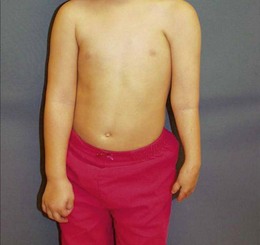CHAPTER 40 Surgery of the Breast in Poland’s Syndrome
Summary/Key Points
Poland’s Syndrome or Poland Anomaly – Introduction
These findings were published in 1841 in the Reports of Guys Hospital in London by Sir Alfred Poland who did a prosection (laboratory dissection) of an upper extremity in a patient with syndactyly.1 In 1962 a plastic surgeon named Patrick Clarkson also working in London at Guys Hospital encountered a series of three patients with hand abnormalities with accompanying breast hypoplasia. Clarkson reported these three cases2 and also found the original hand specimen that had been dissected by Poland, which had been kept in the museum of Guys Hospital.
Patient Selection
Indications
Clinical presentation
Patients with Poland’s syndrome are usually seen early in life for evaluation of upper extremity abnormalities. These are either syndactyly or synbrachydactyly and some element of upper extremity hypoplasia. A typical example of a young female patient is illustrated in Fig. 40.1.
Absence of the anterolateral axillary fold is apparent during early childhood but problems with breast development may not be apparent. The potential of problems with breast development is discussed with the parents and plans are made to periodically follow patients through their young teenage years and into late adolescence (Fig. 40.2)
Alternatively, it is not uncommon for patients with breast development problems to present for the first time during the late phases of puberty for plastic surgery consultation (Fig. 40.2)











